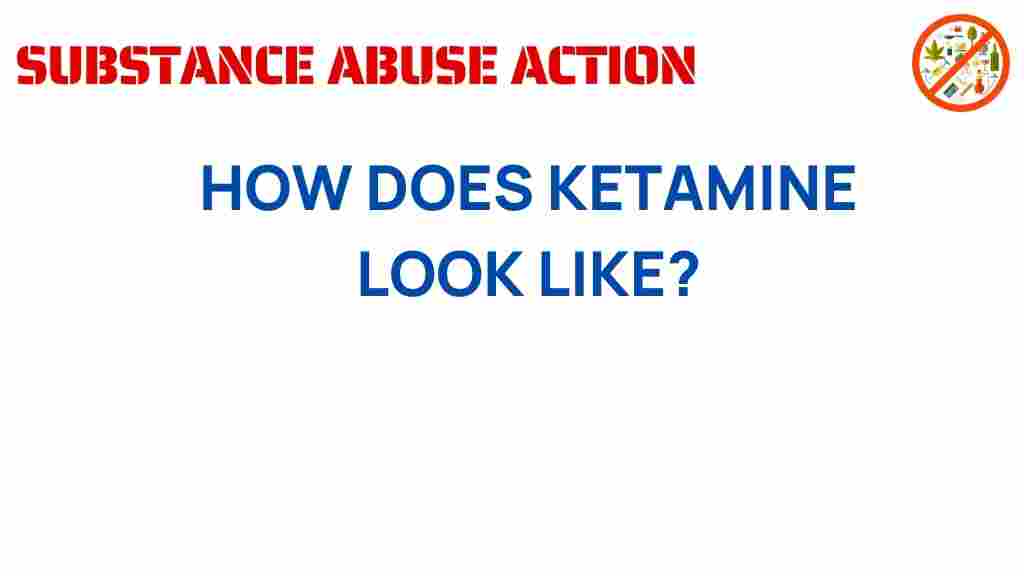Unveiling the Mystique: What Does Ketamine Really Look Like?
Ketamine, a substance that has garnered attention in both the medical and recreational realms, is often shrouded in mystique. With its unique properties as a dissociative anesthetic, its appearance can vary based on its form—be it pharmaceutical, illicit, or recreational. In this article, we will delve deep into the visual characteristics of ketamine, exploring its identification, uses in mental health, and the implications of its recreational use.
Understanding Ketamine and Its Forms
Ketamine was originally developed in the 1960s as a surgical anesthetic. Over time, it has found a place in various medical treatments, particularly in mental health. The drug has several forms, each with distinct visual characteristics.
Pharmaceutical Form of Ketamine
In its pharmaceutical form, ketamine is typically presented as a clear, colorless liquid. It is often administered via injection and can also be found in nasal spray form for specific treatments, particularly for depression. Here are some details regarding its pharmaceutical characteristics:
- Appearance: Clear and colorless liquid.
- Formulation: Available in vials for injection or as a nasal spray.
- Concentration: Commonly 10 mg/mL or 50 mg/mL concentrations in liquid form.
Recreational Use and Its Visual Characteristics
In recreational contexts, ketamine is often misused, and its appearance can differ significantly. The drug is commonly found in the following forms:
- Powder: Ketamine can be found as a white or off-white powder, which is often snorted.
- Pills: Some users may encounter ketamine in pill form, which can be shaped and colored variably.
- Liquid: Similar to its pharmaceutical counterpart, it can also be found in liquid form, but often without labeling or safety controls.
How to Identify Ketamine
Identifying ketamine requires an understanding of its various forms and characteristics. Here’s a step-by-step guide to help with substance identification:
Step 1: Observe the Physical Characteristics
Check the appearance of the substance:
- If it is liquid, it should be clear and colorless.
- If in powder form, it should be a fine white or off-white powder.
- Pills may vary in color and shape, so it’s essential to be cautious.
Step 2: Conduct a Smell Test
Ketamine has a faint chemical smell. If the substance has a strong or unusual odor, it may not be ketamine.
Step 3: Consider the Source
Evaluate where the substance came from:
- Pharmaceutical ketamine is obtained from licensed medical professionals.
- Illicit ketamine may come from unregulated sources, increasing the risk of contamination.
Step 4: Perform a Simple Test (if safe to do so)
If you have access to testing kits, you can use them to confirm the presence of ketamine. These kits can test for other substances and impurities.
Ketamine in Mental Health Treatment
In recent years, ketamine has emerged as a groundbreaking treatment for various mental health conditions, particularly treatment-resistant depression. Its unique mechanism allows it to act quickly compared to traditional antidepressants. Here’s how it works:
- Psychedelic Properties: Ketamine has psychedelic effects that can lead to altered perceptions and dissociation, which some studies suggest may help patients process trauma.
- Rapid Action: Unlike conventional antidepressants that may take weeks to show effects, ketamine can provide relief within hours.
- Routes of Administration: It can be administered intravenously, intramuscularly, or as a nasal spray.
The Benefits of Ketamine Therapy
Research indicates several benefits of using ketamine in therapeutic settings:
- Fast-acting relief from depressive symptoms.
- Potential to reduce suicidal ideation.
- Ability to enhance emotional processing and resilience.
Risks and Considerations of Recreational Use
While ketamine can be beneficial in controlled medical settings, its recreational use poses several risks:
- Potential for Abuse: Ketamine can lead to dependence and abuse due to its psychoactive effects.
- Health Risks: Recreational use can result in serious health issues, including bladder problems and cognitive impairment.
- Legal Status: In many regions, recreational use of ketamine is illegal and can lead to legal consequences.
Visual Characteristics of Recreational Ketamine
When identifying recreational ketamine, be aware of the following:
- Powdered forms may appear similar to other street drugs, increasing the risk of misidentification.
- Contaminants may change the appearance, color, and smell of the substance.
Troubleshooting Tips for Safe Use
If you are considering ketamine for therapeutic purposes, or if you encounter it in a recreational context, here are some tips to ensure safety:
Choosing a Treatment Center
- Ensure that the facility is licensed and adheres to safety regulations.
- Consult with a healthcare provider about the potential benefits and risks.
Handling Recreational Use Responsibly
- Be cautious of unknown sources and avoid using substances from unreliable vendors.
- Consider discussing your intentions with a healthcare professional.
Conclusion
Ketamine’s journey from a surgical anesthetic to a promising mental health treatment has opened new avenues for understanding its visual characteristics and implications. Whether in its pharmaceutical form or as a recreational substance, recognizing ketamine’s diverse appearances is essential for safe identification and use.
As society continues to explore the therapeutic potentials of ketamine, it is crucial to balance the benefits with the risks associated with its recreational use. For those interested in learning more about ketamine therapy and its applications in mental health, consider visiting this resource for comprehensive information. Additionally, if you want to explore further about substance identification, you can check out this guide for more insights.
This article is in the category Treatment and created by SubstanceAbuseAction Team
